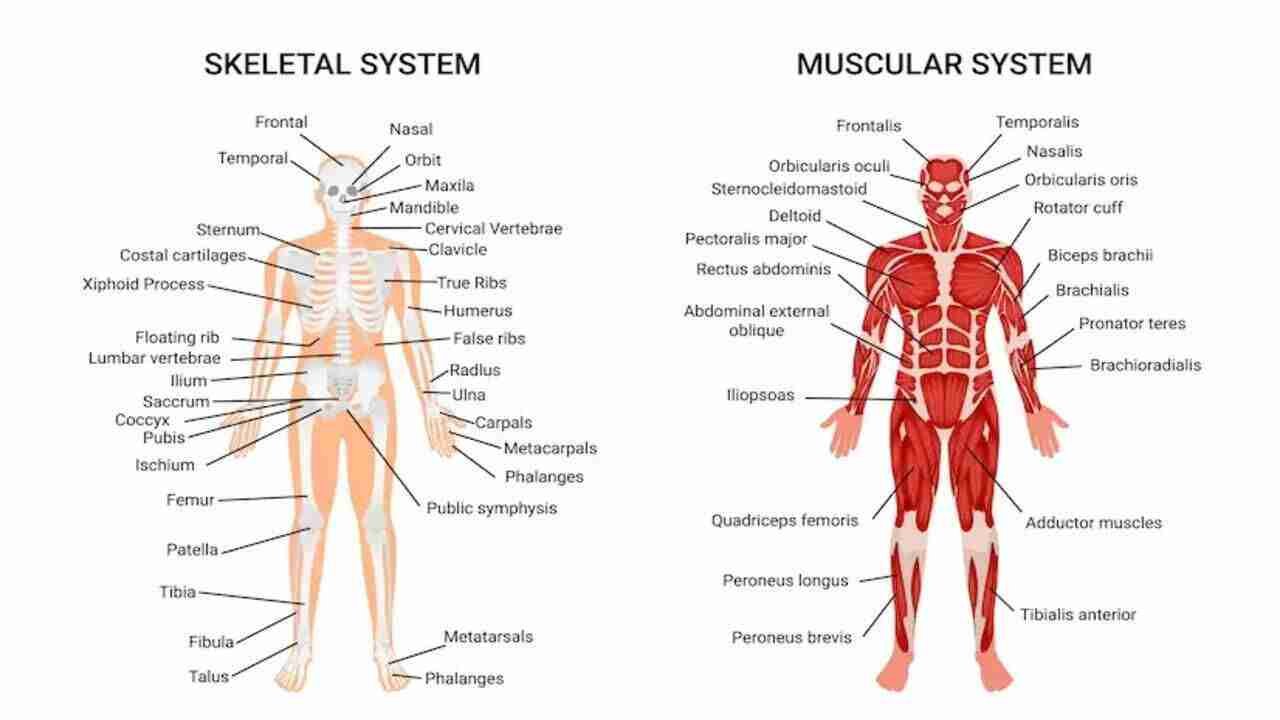The human body is an intricate and fascinating biological marvel, composed of numerous organs, tissues, and systems working harmoniously to sustain life. Knowing the names and functions of various body parts is not only essential for medical professionals but also for every individual to understand their own body better and maintain good health.

In this article, we’ll delve into an exploration of the different body parts, their names, and their functions.
1. Head and Neck:
- Brain: The control center of the body, responsible for processing information, controlling movement, and regulating bodily functions.
- Eyes: Organs of vision, enabling us to perceive the world around us.
- Nose: The organ of smell and a part of the respiratory system, responsible for breathing and detecting odors.
- Mouth: Used for eating, speaking, and breathing. Contains teeth, tongue, and salivary glands.
- Ears: Organs of hearing and balance, consisting of the outer ear, middle ear, and inner ear.
- Throat: Passage for food and air, containing the pharynx, larynx, and esophagus.
2. Torso:
- Heart: A muscular organ that pumps blood throughout the body, supplying oxygen and nutrients to tissues.
- Lungs: Organs of respiration, responsible for exchanging oxygen and carbon dioxide with the blood.
- Stomach: A digestive organ where food is broken down and partially digested.
- Liver: Performs various metabolic functions, including detoxification and the production of bile.
- Intestines: The digestive tract, consisting of the small intestine and large intestine, where nutrients are absorbed and waste is processed.
- Kidneys: Filter waste products from the blood and regulate fluid balance and electrolytes.
- Spleen: Involved in immune function and the filtering of blood.
- Pancreas: Produces digestive enzymes and hormones such as insulin to regulate blood sugar levels.
3. Arms and Hands:
- Shoulder: The joint connecting the arm to the torso.
- Upper Arm: The part of the arm between the shoulder and elbow.
- Elbow: The joint between the upper arm and forearm.
- Forearm: The part of the arm between the elbow and wrist.
- Wrist: The joint connecting the forearm to the hand.
- Hand: Consists of the palm, fingers, and thumb, used for grasping and manipulating objects.
4. Legs and Feet:
- Hip: The joint connecting the leg to the torso.
- Thigh: The part of the leg between the hip and knee.
- Knee: The joint between the thigh and lower leg.
- Lower Leg: The part of the leg between the knee and ankle.
- Ankle: The joint connecting the lower leg to the foot.
- Foot: Consists of the sole, toes, and heel, providing support and mobility.
Understanding the names and functions of these body parts is crucial for maintaining overall health and well-being. Whether for personal knowledge or professional purposes, familiarity with the human body promotes better self-care and facilitates effective communication with healthcare providers. Take the time to learn about your body, and you’ll be better equipped to nurture and protect it for a lifetime of health and vitality.
Top 20 FAQs about Understanding the Human Body
- What is the purpose of understanding the human body?
- Understanding the human body is essential for maintaining good health, identifying symptoms of illness, and making informed decisions about medical care.
- How many bones are there in the human body?
- The human body typically has 206 bones, which provide structure, support, and protection to the organs and tissues.
- What are the main organs of the respiratory system?
- The main organs of the respiratory system include the lungs, trachea (windpipe), bronchi, and diaphragm.
- What role does the circulatory system play in the body?
- The circulatory system, composed of the heart, blood vessels, and blood, transports oxygen, nutrients, and hormones throughout the body and removes waste products.
- How does the digestive system function?
- The digestive system breaks down food into nutrients, which are absorbed by the body for energy and growth, while waste products are eliminated.
- What are the primary functions of the liver?
- The liver performs various essential functions, including detoxification, metabolism of nutrients, and production of bile for digestion.
- Why is the brain considered the control center of the body?
- The brain regulates bodily functions, processes sensory information, controls movement, and coordinates responses to stimuli, making it the control center of the body.
- What are the major parts of the nervous system?
- The nervous system consists of the brain, spinal cord, and peripheral nerves, which transmit electrical signals to coordinate bodily functions and respond to stimuli.
- How do muscles work in the body?
- Muscles contract and relax to produce movement, stabilize joints, generate heat, and support the body’s structure and posture.
- What is the purpose of the lymphatic system?
- The lymphatic system helps maintain fluid balance, removes waste products and toxins from tissues, and supports the body’s immune defenses against infections.
- What causes joint pain and how can it be managed?
- Joint pain can be caused by injury, inflammation, arthritis, or overuse. Management may include rest, medication, physical therapy, and lifestyle modifications.
- How does the body maintain balance and equilibrium?
- Balance and equilibrium are maintained by the inner ear, which detects changes in position and movement, and by sensory receptors in muscles and joints.
- What are the risks of poor posture and how can it be corrected?
- Poor posture can lead to musculoskeletal pain, fatigue, and reduced mobility. Corrective measures may include ergonomic adjustments, exercise, and posture training.
- What are the common causes of back pain?
- Common causes of back pain include muscle strain, injury, poor posture, arthritis, and spinal conditions such as herniated discs or sciatica.
- Why is it important to protect your hearing?
- Protecting your hearing is essential to prevent hearing loss, which can be caused by exposure to loud noises, aging, genetic factors, and certain medical conditions.
- How does diet affect overall health and well-being?
- A balanced diet rich in nutrients is essential for maintaining optimal health, supporting bodily functions, and reducing the risk of chronic diseases.
- What are the benefits of regular exercise for the body?
- Regular exercise improves cardiovascular health, strengthens muscles and bones, enhances mood and mental well-being, and reduces the risk of obesity and chronic diseases.
- What are the warning signs of a heart attack or stroke?
- Warning signs of a heart attack include chest pain, shortness of breath, nausea, and arm pain. Signs of a stroke include sudden weakness, numbness, confusion, and difficulty speaking or walking.
- How does stress affect the body and what are effective coping strategies?
- Stress can negatively impact physical and mental health, leading to increased risk of chronic diseases and mental health disorders. Coping strategies may include relaxation techniques, exercise, and seeking support.
- What steps can I take to maintain overall health and well-being?
- Maintaining overall health and well-being involves adopting a balanced diet, staying physically active, getting enough sleep, managing stress, avoiding harmful habits such as smoking and excessive alcohol consumption, and seeking regular medical check-ups.
Register for My Upcoming Masterclass HERE
See You in the Live Masterclass
Sunil Chaudhary stands as a preeminent global Leading digital coach, boasting a diverse clientele hailing from over 50 nations. Renowned for his prowess as an exemplary SEO expert, business automation coach, and landing page authority, Chaudhary also holds the distinction of being esteemed as the finest business coach in India. Beyond technical domains, he imparts invaluable insights into mindset, success, and life skills, thus encompassing a holistic approach to mentorship.



